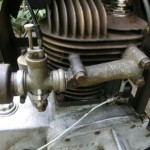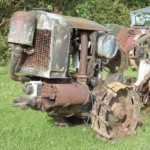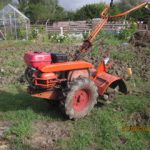Home › Forums › The Machinery Forums › Pedestrian operated machines › BMB cult mate
- This topic has 10 replies, 8 voices, and was last updated 11 years, 7 months ago by
 vhgmcbuddy.
vhgmcbuddy.
-
AuthorPosts
-
November 11, 2013 at 7:31 pm #2861
 vhgmcbuddyMember
vhgmcbuddyMemberHi folks
I have recently pulled an old walk behind plough from the jaws of the scrap man and identified it as a BMB cult mate.
Unfortunately there is no engine or tin work but the gearbox is in good nick and I have managed to free off all the parts to set the plough.
I have put a new pulley on the gearbox and fitted a 8 hp briggs engine and hope to have some fun in my neighbours walled garden soon.
The moldboard looks hardly worn but is quite rusty with some signs of pitting and i wondered if any one could tell me how to clean it up ?
Also will 8 hp be enough power for ploughing and if so what depth and width of furrow could I expect to plough ?
any help or tips would be appreciated. I hope no one minds me modernising the old girl but had i not stepped in she would be on a slow boat to china destined to be a washing machine or somethingNovember 11, 2013 at 8:00 pm #2862 hillsiderParticipant
hillsiderParticipantTo clean up the mouldboard of the plough I would try to use an abrasive flap disc fitted to an angle grinder or failing that a flap wheel in an electric drill. An angle grinder with a grinding disc fitted would be too fierce and would remove the metal rather than just the corrosion. Which ever method you use please wear some eye protection and a nuisance dust mask this will protect your eyes and help you to breath clean air during the rust removal process.
Re the suitability of the replacement engine I guess the proof of the pudding is in the eating!! You won’t know until you try it.November 11, 2013 at 8:11 pm #2864 wristpinParticipant
wristpinParticipantJust go ploughing with it – will soon be bright and shiny! Then don’t forget to grease it up afterwards.
November 11, 2013 at 10:27 pm #2888 hillsiderParticipant
hillsiderParticipantI quite agree a few hours ploughing will clean it up really well, especially if the soil is dry and stony but if it is wet and claggy some pre cleaning will make all the difference to how the the soil turns over.
Definitely follow Wristpins advice re greasing the shiny bits after use though.November 11, 2013 at 10:50 pm #2903 vhgmcbuddyMember
vhgmcbuddyMemberI use a soft brick to clean up the very rusty ones here, other than that the best thing is to find a sandy place and plow away at it. I always carry a small putty knife, to clean off the stuck on places. After plowing we spray the shiny parts with Slip-Plate, as the grease draws to much dirt/dust and is messy to handle.
November 12, 2013 at 8:19 am #2929 charlieKeymaster
charlieKeymasterAlways better to have a machine up and running than sat in a corner with no engine. You can always convert to correct engine at a later date if you want/find one. 8hp should be enough, the SIMAR 56 is an 8hp 2 stroke and pulls a similar sized plough, (might even be a bit bigger). I remember a group of us discussing the subject of cleaning up ploughs and someone suggested finding a suitable beach, the only problem would be the salt rusting the plough very quickly after work finished.
November 12, 2013 at 9:23 pm #2970 sidevalve44Participant
sidevalve44ParticipantI use used cooking oil on the tines of my Rotovator after I’ve cleaned it. Seems to work quite well, as long as you can put up with the strange smell !
November 13, 2013 at 3:50 pm #2985 vhgmcbuddyMember
vhgmcbuddyMemberThanks folks for your replies. I started using a 40 grit flappy pad on my nine inch angle grinder but the pitting is to deep so I have had to use a grinding disc instead,taking 2 or 3 mm of metal of the mouldboard. I have then used the flappy disc to take out the scratches left by the disc and hope that it is now almost ready to go .
November 13, 2013 at 11:18 pm #3010 vhgmcbuddyMember
vhgmcbuddyMemberI think 8 hp. is more that adequate for a Cultimate, I think the original engine was only about 4 hp, The Hoemate which also had a plough was only about 2hp, in fact the Big Ploughmate was not 8hp, someone will correct me if I am wrong, these old machines all worked with low hp, and clever gearing and of course weights when ploughing!.it always amazes me at ploughing events how good a result some ploughmen get with the small machines.
November 15, 2013 at 10:05 pm #3075 sidevalve44Participant
sidevalve44ParticipantI guess one of the reasons these old units worked well on relatively low HP is the torque of the engine rather than its outright HP.
The 3HP B&S engine on my Wizard is only 125cc, the Villiers MK25 is also 3HP but, is 256cc. It would therefore follow that the Villiers is likely to be a more torquey engine. That and low gearing enabled them to use relatively low HP engines.November 23, 2013 at 6:35 am #3281 vhgmcbuddyMember
vhgmcbuddyMembercould you post a few photos because if its what I think it is I saw 3 parked up in an orchard once and one was huge. in fact it must have been at least 4 to 5 feet wide on the wheel width and the distance between the handle bars was about3 ft 6 to 4 ft wide . I also think they had big jap engines attached
-
AuthorPosts
- You must be logged in to reply to this topic.
